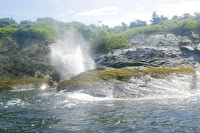 |
| View from the put-in at the Bay Campus |
There are three lighthouses on the West Passage of Narragansett Bay that I have been trying to get pictures of from the water – Dutch Island Light, Beavertail Light, and Plum Beach Light. Dutch Island Light is easy being just outside Dutch Harbor. Beavertail is also easy if you take the pictures from shore – not so much from the water. Plum Beach Light has always eluded me being just outside my comfort level for paddling alone. That changed yesterday when Tony agreed to take me out in one of his sea kayaks.
Tony needed to return the RICKA Volunteer of the Year trophy, so we decided to take the opportunity to do some paddling. Tony gave me lots of options, but we decided to launch from the URI Bay Campus. We met at 8:30 and unloaded the boats. The day was beautiful, with wind out of the north kicking up 1’ waves. Combined with the usual boat wake, it would be easy for Tony, but a little challenging for me.
 |
| Dutch Island Light |
We decided to cross over to Dutch Island, and then head south to Beavertail. I would be paddling a 17’ Heritage sit-on-top sea kayak. It seemed a little tippy at first, but I got use to it. My first real test came about half way across the West Passage when a large motorboat sped by creating 2-3’ wake. I bounced over fine and we continued to Dutch Island.
Dutch Island took its name from the Dutch East India Company that established a trading post here around 1636. The first lighthouse was completed on the southern tip of the island in 1826. The original tower was replaced with the current tower in 1857. The lighthouse remained in service until 1979 when it was replaced with a flashing buoy. It then fell into disrepair until 2007 when it was restored by the Dutch Island Lighthouse Society.
 |
| Beavertail Light |
From Dutch Island we headed south toward Beavertail. Records from the town of Jamestown make reference to a beacon here as early as 1712. A wooden tower known as the “Newport Light” was built in 1749. It burned and was replaced with a stone tower 4-years later. In 1856, the original stone tower was replaced with the current granite tower. It is 10’ square and 64’ tall. The lighthouse was restored and opened to the public in 1989 and includes a museum is operated by the Beavertail Lighthouse Museum Association.
As we headed south it took me a little while to get use to paddling in a following wind. As we approached Beavertail we also had to deal with rolling waves coming in from the open water. I did my best to click a few pictures of the lighthouse, but I was more concerned about staying upright. When Tony rose up and then disappeared behind a 3 ' rolling wave, I decided that I gone far enough. I clicked my last picture, and we turned around and headed north, taking a break in one of the secluded beaches in the cliffs.
 |
| Tony get a shower |
We headed back to Dutch Harbor and took a break for lunch near the boat dock at Fort Getty. From there we crossed back to Dutch Island to get a few more pictures of the lighthouse. We continued up the west side of the island, and then we had a decision to make. We could play it safe and explore Dutch Harbor, or we could head north toward the Jamestown Bridge to get some pictures of the Plum Beach Light. We decided to head to Plum Beach Light.
The sparkplug shaped Plum Beach Light was built in 1899 using pneumatic caisson engineering – a new innovation at the time. The granite base was added in 1922. The light was deactivated in 1941 when the first Jamestown Bridge was built. It remained abandoned until 2003 when the lighthouse's exterior was completely restored by the Friends of the Plum Beach Light.
 |
| Plum Beach Light |
In order to get to the Plum Beach Light we had to cross the boat channel to the North Kingstown side, and then head north under the Jamestown Bridge. The wind had died down, but boat wake continued to roll in from across the bay. Still, it was amazing to sit at the base of this lighthouse that had always seemed just out of reach.
After clicking a few pictures we turned and headed back to the put-in. In total we paddled 14-miles if you believe Google Maps – it didn’t seem that far, but no wonder I was tired.
Links:




No comments:
Post a Comment
Note: Only a member of this blog may post a comment.